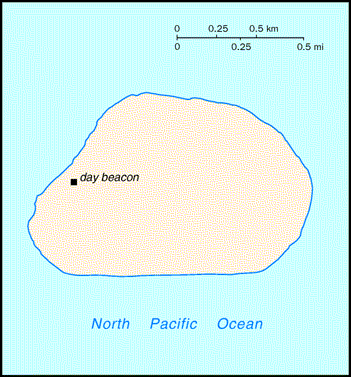| Introduction | Baker Island |
|
Background:
|
The US took possession of the island in 1857, and its guano deposits were mined by US and British companies during the second half of the 19th century. In 1935, a short-lived attempt at colonization was begun on this island - as well as on nearby Howland Island - but was disrupted by World War II and thereafter abandoned. Presently the island is a National Wildlife Refuge run by the US Department of the Interior; a day beacon is situated near the middle of the west coast. |
| Geography | Baker Island |
|
Location:
|
Oceania, atoll in the North Pacific Ocean, about half way between Hawaii and Australia |
|
Geographic coordinates:
|
0 13 N, 176 31 W |
|
Map references:
|
Oceania |
|
Area:
|
total: 1.4 sq km
land: 1.4 sq km water: 0 sq km |
|
Area - comparative:
|
about 2.5 times the size of The Mall in Washington, DC |
|
Land boundaries:
|
0 km |
|
Coastline:
|
4.8 km |
|
Maritime claims:
|
territorial sea: 12 nm
exclusive economic zone: 200 nm |
|
Climate:
|
equatorial; scant rainfall, constant wind, burning sun |
|
Terrain:
|
low, nearly level coral island surrounded by a narrow fringing reef |
|
Elevation extremes:
|
lowest point: Pacific Ocean 0 m
highest point: unnamed location 8 m |
|
Natural resources:
|
guano (deposits worked until 1891), terrestrial and aquatic wildlife |
|
Land use:
|
arable land: 0%
permanent crops: 0% other: 100% (2001) |
|
Irrigated land:
|
0 sq km (1998 est.) |
|
Natural hazards:
|
the narrow fringing reef surrounding the island can be a maritime hazard |
|
Environment - current issues:
|
no natural fresh water resources |
|
Geography - note:
|
treeless, sparse, and scattered vegetation consisting of grasses, prostrate vines, and low growing shrubs; primarily a nesting, roosting, and foraging habitat for seabirds, shorebirds, and marine wildlife |
| People | Baker Island |
|
Population:
|
uninhabited
note: American civilians evacuated in 1942 after Japanese air and naval attacks during World War II; occupied by US military during World War II, but abandoned after the war; public entry is by special-use permit from US Fish and Wildlife Service only and generally restricted to scientists and educators; a cemetery and remnants of structures from early settlement are located near the middle of the west coast; visited annually by US Fish and Wildlife Service (2005 est.) |
| Government | Baker Island |
|
Country name:
|
conventional long form: none
conventional short form: Baker Island |
|
Dependency status:
|
unincorporated territory of the US; administered from Washington, DC, by the Fish and Wildlife Service of the US Department of the Interior as part of the National Wildlife Refuge system |
|
Legal system:
|
the laws of the US, where applicable, apply |
|
Flag description:
|
the flag of the US is used |
| Economy | Baker Island |
|
Economy - overview:
|
no economic activity |
| Transportation | Baker Island |
|
Ports and harbors:
|
none; offshore anchorage only; note - there is one small boat landing area along the middle of the west coast |
|
Airports:
|
1 abandoned World War II runway of 1,665 m, completely covered with vegetation and unusable (2004 est.) |
|
Transportation - note:
|
there is a day beacon near the middle of the west coast |
| Military | Baker Island |
|
Military - note:
|
defense is the responsibility of the US; visited annually by the US Coast Guard |
| Transnational Issues | Baker Island |
|
Disputes - international:
|
none |
Sources: The CIA World Fact Book and other public domain Internet sites
